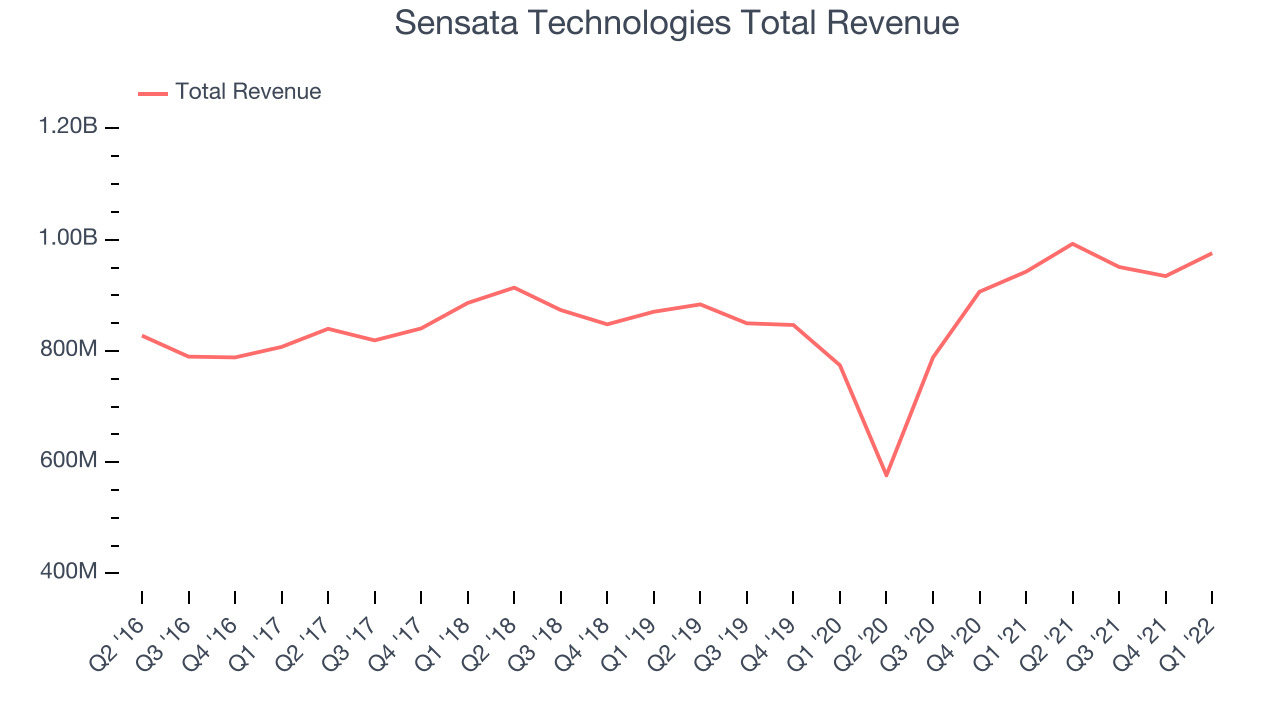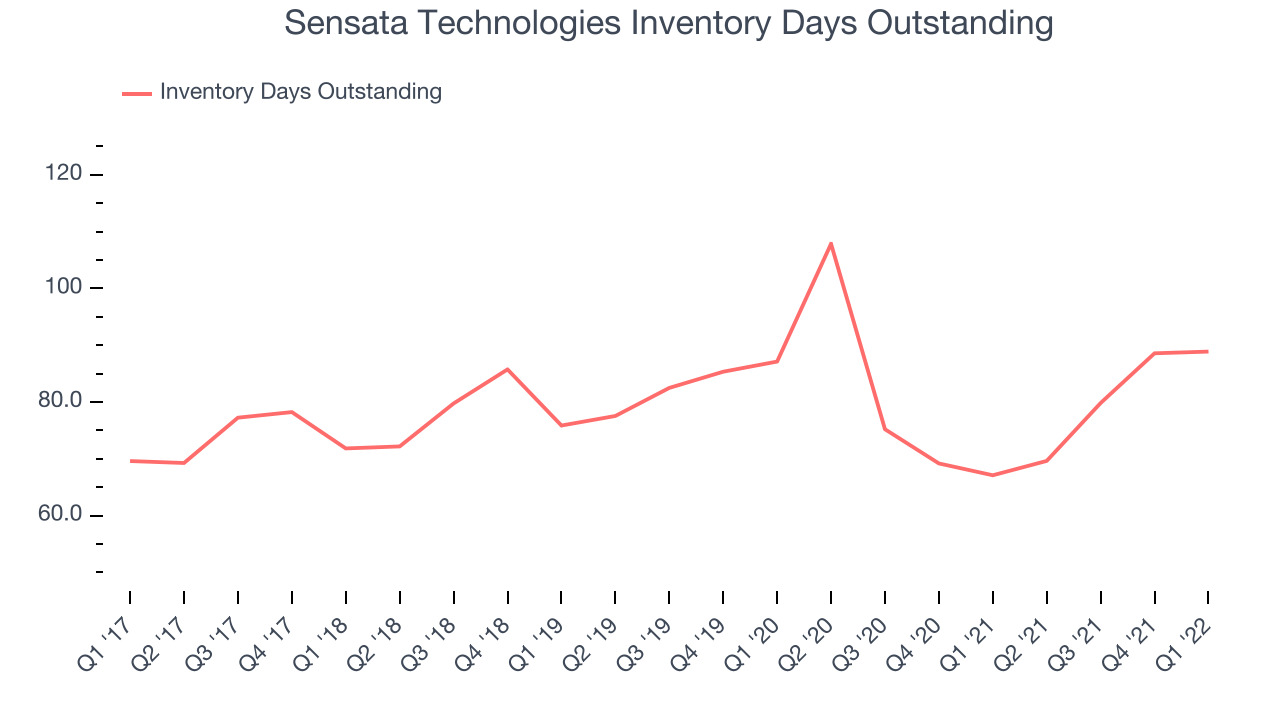Sensor manufacturer Sensata Technology (NYSE:ST) beat analyst expectations in Q1 FY2022 quarter, with revenue up 3.52% year on year to $975.7 million. Guidance for the full year also slightly exceeded estimates, however the guidance for the next quarter was less impressive, coming in at $1.01 billion, 4.05% below analyst estimates. Sensata Technologies made a GAAP profit of $22.4 million, down on its profit of $53.7 million, in the same quarter last year.
Is now the time to buy Sensata Technologies? Access our full analysis of the earnings results here, it's free.
Sensata Technologies (ST) Q1 FY2022 Highlights:
- Revenue: $975.7 million vs analyst estimates of $960.6 million (1.57% beat)
- EPS (non-GAAP): $0.78 vs analyst estimates of $0.76 (2.43% beat)
- Revenue guidance for Q2 2022 is $1.01 billion at the midpoint, below analyst estimates of $1.05 billion
- The company reconfirmed revenue guidance for the full year, at $4.2 billion at the midpoint
- Free cash flow of $11.6 million, down 90% from previous quarter
- Inventory Days Outstanding: 89, up from 89 previous quarter
- Gross Margin (GAAP): 32.6%, in line with same quarter last year
“Sensata delivered higher than targeted revenue in the first quarter due to strong market outgrowth and acquired growth of 7.9% and 4.1% respectively, despite market headwinds of 5.8%. Lower volumes and increased investments in our Megatrend growth areas are weighing on margins, but these investments position Sensata for growth as evidenced by our demonstrated outgrowth and record new business wins.” said Jeff Cote, CEO and President of Sensata.
Originally a temperature sensor control maker and part of Texas Instruments for 60 years, before eventually being spun out, Sensata Technology Holdings (NYSE: ST) is a leading supplier of analog sensors used in industrial and transportation applications, best known for its dominant position in the tire pressure monitoring systems in cars.
Demand for analog chips is generally linked to the overall level of economic growth, as analog chips serve as the building blocks of most electronic goods and equipment. The biggest secular growth drivers currently are the adoption of electric vehicles, 5G networks and Internet of Things connectivity, and demand for chips that reduce power consumption. Unlike digital chip designers, analog chip makers tend to produce the majority of their own chips, as analog chip production does not require expensive leading edge nodes. Less dependent on major secular growth drivers, analog product cycles are much longer, often 5-7 years.
Sales Growth
Sensata Technologies's revenue growth over the last three years has been unimpressive, averaging 5.75% annually. But as you can see below, last year has been stronger for the company, growing from quarterly revenue of $942.5 million to $975.7 million. Semiconductors are a cyclical industry and long-term investors should be prepared for periods of high growth, followed by periods of revenue contractions (which can sometimes offer opportune times to buy).

While Sensata Technologies beat analysts' revenue estimates, this was a very slow quarter with just 3.52% revenue growth. This marks 6 straight quarters of revenue growth, implying we are mid-cycle for Sensata Technologies, as a typical upcycle tends to last 8-10 quarters.
Sensata Technologies believes the slow growth is set to continue, and is guiding for revenue to grow 1.74% YoY next quarter, and Wall St analysts are estimating growth 11.5% over the next twelve months.
There are others doing even better than Sensata Technologies. Founded by ex-Google engineers, a small company making software for banks has been growing revenue 90% year on year and is already up more than 150% since the IPO last December. You can find it on our platform for free.
Product Demand & Outstanding Inventory
Days Inventory Outstanding (DIO) are an important metric for chipmakers, as it reflects the capital intensity of the business and the cyclical nature of semiconductor supply and demand. In a tight supply environment, inventories tend to be stable, allowing chipmakers to exert pricing power. Steadily increasing DIO can be a warning sign that demand is weak, and if inventories continue to rise the company may have to downsize production.

This quarter, Sensata Technologies’s inventory days came in at 89, 9 days above the five year average, suggesting that inventory levels are staying higher than what we used to see in the past.
Key Takeaways from Sensata Technologies's Q1 Results
With a market capitalization of $7.65 billion Sensata Technologies is among smaller companies, but its more than $1.6 billion in cash and positive free cash flow over the last twelve months put it in a very strong position to invest in growth.
It was good to see Sensata Technologies outperform Wall St’s earnings expectations this quarter. And we were also happy to see it topped analysts’ revenue expectations, even if just narrowly. On the other hand, it was unfortunate to see that the revenue guidance for the next quarter missed analysts' expectations and the revenue growth was quite weak. Overall, this quarter's results could have been better. The company is flat on the results and currently trades at $48.73 per share.
Sensata Technologies may have had a tough quarter, but does that actually create an opportunity to invest right now? It is important that you take into account its valuation and business qualities, as well as what happened in the latest quarter. We look at that in our actionable report which you can read here, it's free.
One way to find opportunities in the market is to watch for generational shifts in the economy. Almost every company is slowly finding itself becoming a technology company and facing cybersecurity risks and as a result, the demand for cloud-native cybersecurity is skyrocketing. This company is leading a massive technological shift in the industry and with revenue growth of 70% year on year and best-in-class SaaS metrics it should definitely be on your radar.
The author has no position in any of the stocks mentioned.
